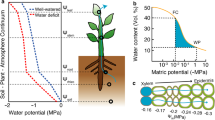Summary
Measurements of gas exchange, xylem tension and nocturnal malate synthesis were conducted with well-watered and droughted plants of Kalanchoë uniflora. Corresponding results were obtained with plants grown in 9 h and 12 h photoperiods. In well-watered plants, 50 to 90% of total CO2-uptake occurred during the light period. Nocturnal CO2-uptake and malate synthesis were higher and respiration rate was lower in old leaves (leaf pairs 6 to 10) compared to young leaves (leaf pairs 1 to 5). Within four days of drought distinct physiological changes occurred. Gas exchange during the light period decreased and CO2-uptake during the dark period increased. Nocturnal malate synthesis significantly increased in young leaves.
Respiration rate decreased during periods of drought, this decrease being more pronounced in young leaves compared to old leaves. Restriction of gas exchange during the light period resulted in a decrease of transpiration ratio from more than 100 to about 20. The difference between osmotic pressure and xylem tension decreased in young leaves, indicating a reduction in bulk leaf turgor-pressure.
We conclude that both the CAM-enhancement in young leaves and the decrease of respiration rate are responsible for the increase of nocturnal CO2-uptake during water stress. During short drought periods, which frequently occur in humid habitats, the observed physiological changes result in a marked reduction of water loss while net CO2-uptake is maintained. This might be relevant for plant growth in the natural habitat.
Similar content being viewed by others
Abbreviations
- LP:
-
light period
- DP:
-
dark period
- CAM:
-
crassulacean acid metabolism
References
Acevedo E, Hsiao TC, Henderson DW (1971) Immediate and subsequent growth responses of maize leaves to changes in water status. Plant Physiol 48:631–636
Boyer JS (1968) Relationship of water potential to growth of leaves. Plant Physiol 43:1056–1062
Brulfert J, Guerrier D, Queiroz O (1982) Photoperiodism and crassulacean acid metabolism II. Relations between leaf aging and photoperiod in crassulacean acid metabolism induction. Planta 154:332–338
Deléens E, Queiroz O (1984a) CAM and carbon isotope composition: origin of the constitutive carbon in young leaves of Bryophyllum daigremontianum Berger. Plant Cell Environ 7:23–27
Deléens E, Queiroz O (1984b) Effects of photoperiod and ageing on the carbon isotope composition of Bryophyllum daigremontianum Berger. Plant Cell Environ 7:279–283
Griffiths H, Smith JAC (1983) Photosynthetic pathways in the Bromeliaceae of Trinidad: relations between life-forms, habitat preference and the occurrence of CAM. Oecologia (Berlin) 60:176–184
Hamet R (1933) Observations sur le Kalanchoë uniflora (Stapf) Raymond Hamet. Bull Soc Bot Fr 35:542–548
Hohorst HJ (1970) L-(-)-Malat. Bestimmung mit Malat-Dehydrogenase und NAD. In: Bergmeyer HU (ed) Methoden der enzymatischen Analyse 2nd edn vol 2 Verlag Chemie, Weinheim, pp 1544–1548
Jones MB (1975) The effect of leaf age on leaf resistance and CO2-exchange of the CAM plant Bryophyllum fedtschenkoi. Planta 123:91–96
Kluge M, Lange OL, von Eichmann M, Schmid R (1973) Diurnaler Säurerhythmus bei Tillandsia usneoides: Untersuchungen über den Weg des Kohlenstoffs sowie die Abhängigkeit des CO2-Gaswechsels von Lichtintensität, Temperatur und Wassergehalt der Pflanze. Planta 112:357–372
Koechlin J, Guillaumet J-L, Morat Ph (1974) Flore et végétation de Madagascar. Cramer, Vaduz
Lüttge U, Ball E (1977) Water relation parameters of the CAM plant Kalanchoë daigremontiana in relation to diurnal malate oscillations. Oecologia (Berlin) 31:85–94
Lüttge U, Smith JAC (1986) CAM — Plants. In: Baker DA, Hall JL (eds) Solute transport in plant cells and tissues. Pitman London (in press)
Medina E, Delgado M, Troughton JHm Medina JD (1977) Physiological ecology of CO2 fixation in Bromeliaceae. Flora 166:137–152
Nobel PS (1983) Biophysical plant physiology and ecology. Freeman, San Francisco
Osmond CB (1978) Crassulacean acid metabolism: a curiosity in context. Ann Rey Plant Physiol 29:379–414
Osmond CB (1982) Carbon cycling and stability of the photosynthetic apparatus in CAM. In: Ting IP, Gibbs M (eds) Crassulacean acid metabolism. Waverly Press, Baltimore Maryland, pp 112–127
Richards PW (1952) The tropical rain forest. Cambridge University Press
Ruess BR, Eller BM (1985) The correlation between crassulacean acid metabolism and water uptake in Senecio medley-woodii. Planta 166:57–66
Scholander PF, Hammel HT, Hemmingsen EA, Bradstreet ED (1964) Hydrostatic pressure and osmotic potential in leaves of mangroves and some other plants. Proc NAS 52:119–125
Sinclair R (1983) Water relations of tropical epiphytes I. Relationships between stomatal resistance, relative water content and the components of water potential. J Exp Bot 34:1652–1663
Sinclair R (1984) Water relations of tropical epiphytes III. Evidence for crassulacean acid metabolism. J Exp Bot 35:1–7
Sipes DL, Ting IP (1985) Crassulacean acid metabolism and crassulacean acid metabolism modifications in Peperomia camptotricha. Plant Physiol 77:59–63
Smith JAC, Lüttge U (1985) Day-night changes in leaf water relations associated with the rhythm of crassulacean acid metabolism in Kalanchoë daigremontiana. Planta 163:272–282
Tomos AD, Leigh RA, Shaw CA, Wyn Jones RG (1984) A comparison of methods for measuring turgor pressures and osmotic pressures of cells of red beet storage tissue. J Exp Bot 35:1675–1683
Tyree MT, Hammel HT (1972) The measurement of the turgor pressure and the water relations of plants by the pressure-bomb technique. J Exp Bot 23:267–282
Warburg O, Geissler AW, Lorenz S (1961) CO2-Drucke über Bicarbonat-Carbonatgemischen. Z Naturforsch 16b:283
Winter K (1979) δ 13C values of some succulent plants from Madagascar. Oecologia (Berlin) 40:103–112
Winter K (1985) Crassulacean acid metabolism. In: Barber J, Baker NR (eds) Photosynthetic mechanisms and the environment. Elsevier Science Publishers BV, 329–387
Winter K, Wallace BJ, Stocker GC, Roksandic Z (1983) Crassulacean acid metabolism in australian vascular epiphytes and some related species. Oecologia (Berlin) 57:129–141
Author information
Authors and Affiliations
Rights and permissions
About this article
Cite this article
Schäfer, C., Lüttge, U. Effects of water stress on gas exchange and water relations of a succulent epiphyte, Kalanchoë uniflora . Oecologia 71, 127–132 (1986). https://doi.org/10.1007/BF00377331
Received:
Issue Date:
DOI: https://doi.org/10.1007/BF00377331




